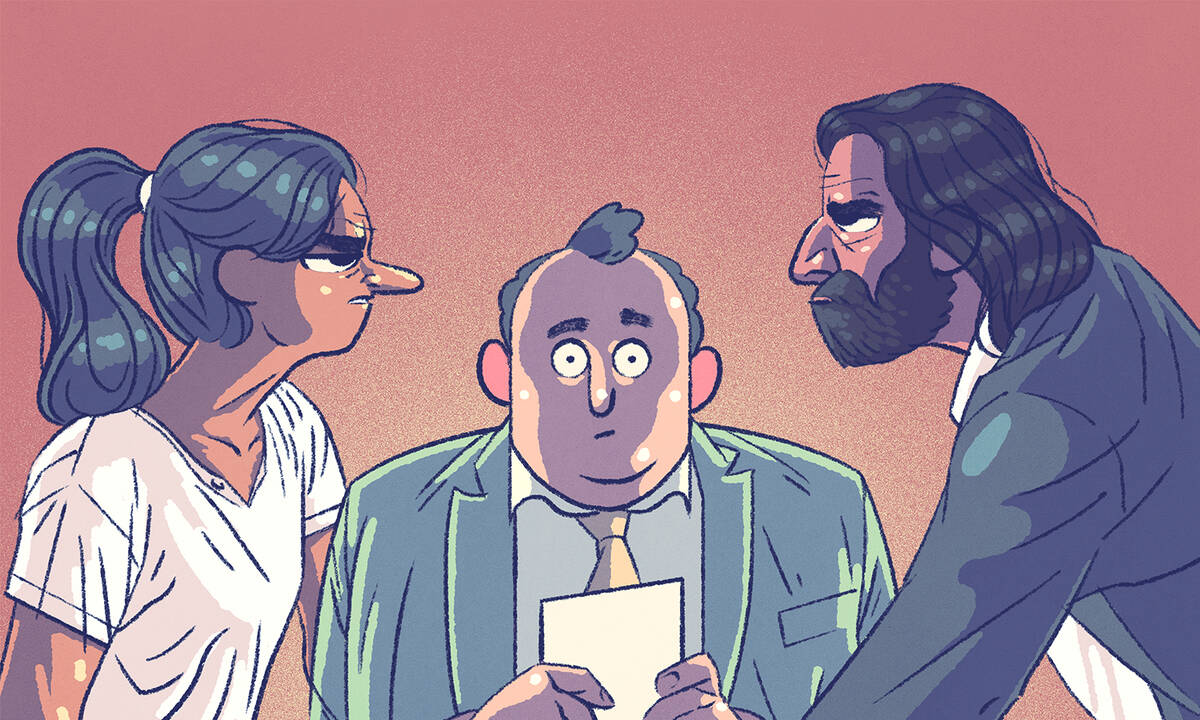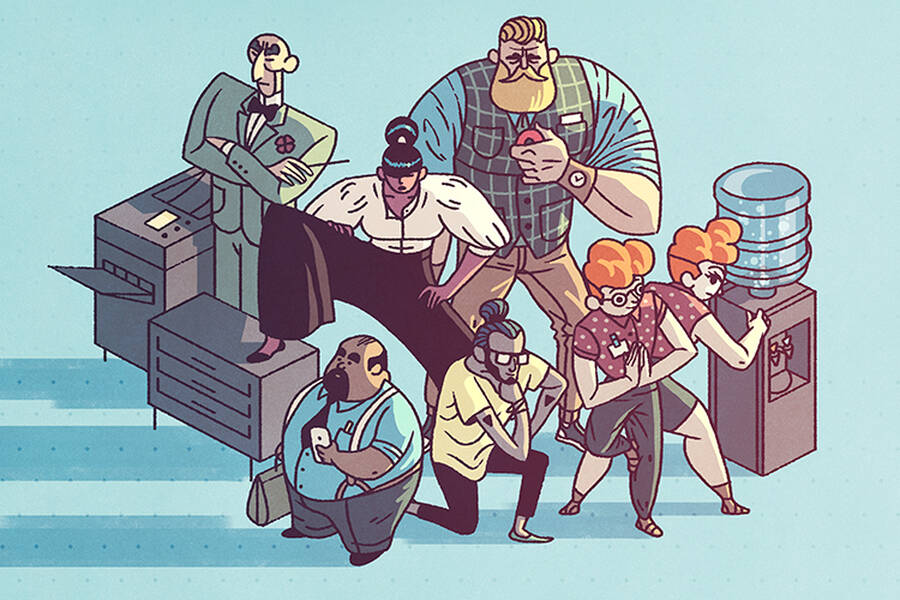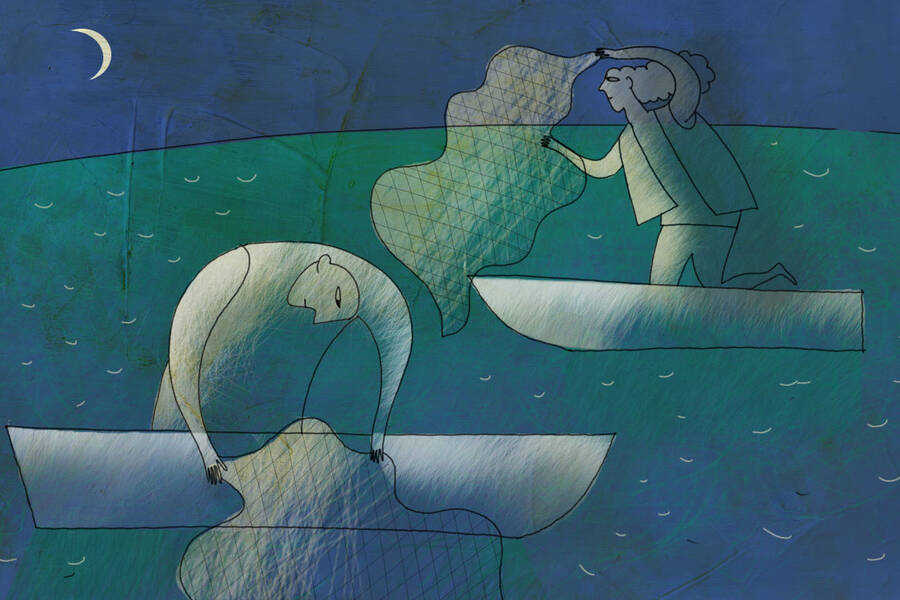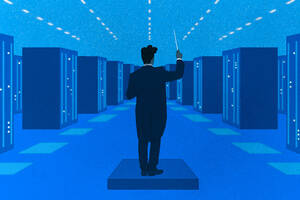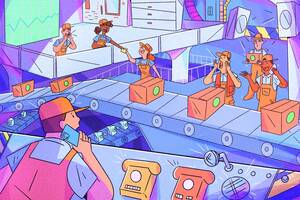You’re friends with two coworkers—say, John and Layla. Individually, you get along great with each person. But John and Layla hate each other. Caught in the middle, you feel pressure to side with one colleague against the other or encourage the two of them to make up.
Academic researchers call this type of triangle “unbalanced.” But do such relationships evolve? Do they settle into a more stable state—for instance, a utopian arrangement of three mutual friends? And how do these triangles affect employees’ job performance?
Brian Uzzi, a professor of management and organizations at Kellogg, and his collaborators set out to answer these questions by analyzing thousands of instant messages between day traders at a financial firm. By categorizing each person’s feelings toward another as positive or negative, they could track how friendship and antagonism changed over two years.
The team found that most types of unbalanced triangles did tend to transform into more stable, or “balanced,” states. And when traders had more balanced social networks, they were more likely to perform better at work.
“They make more profitable trades when their relationships are balanced than when they’re unbalanced,” Uzzi says.
However, the researchers also observed a few types of unbalanced social triangles that tended to stay stuck. In these cases, a manager might want to intervene to resolve relationship issues. Otherwise, the “seeds of unbalanced malcontent” could spread through the office to other people, Uzzi says.
Social Triangles
In the past, researchers who studied relationships often focused on interactions between two parties, or a “dyad,” Uzzi says.
But as research progressed, researchers “realized that the basis of conflict is not truly dyadic,” he says. “It’s triadic.” In other words, third parties often play a key role in introducing or relieving tension.
For instance, imagine a Democratic senator who is friendly with a Republican colleague. The two collaborate well on policy solutions. But when the Republican supports Donald Trump, that alliance weakens the relationship with the Democrat. “If that happens more systematically within a large network, the network will begin to break into two,” Uzzi says—as indeed is the case as U.S. politics becomes increasingly polarized.
To study how such triangles change over time, Uzzi and Jacqueline Ng Lane, a Northwestern University PhD graduate now at Harvard Business School, collaborated with Omid Askarisichani, Francesco Bullo, Noah Friedkin, and Ambuj Singh at the University of California, Santa Barbara.
The researchers studied instant messages sent by 66 day traders at a firm from October 2007 to March 2009. First, the researchers narrowed down the data set to messages sent only within the company. Next, they filtered out messages that contained financial terms such as “stock index” or “S&P 500.” That left about 128,000 messages, which the team reasoned were likely social rather than merely work-related in nature.
The researchers then estimated the intensity of each pair’s social communication based on factors such as the frequency of their messages. If the intensity exceeded a certain threshold, the relationship was considered positive, while any that fell below the threshold was negative.
To analyze the network, the researchers relied on a theoretical framework called structural-balance theory. Under the theory, neutral triangles are not possible. So the team classified the latter relationships as negative rather than simply neutral because the group of people was fairly small, Lane says. The 66 traders had all likely run into each other at some point, and previous research suggests that people form impressions of others quickly. Based on that impression, “you’ve chosen not to talk to them or not to form a relationship,” she says.
Friend or Foe?
Structural-balance theory puts forth four common-sense rules about relationships. First, a friend of a friend is a friend. Second, a friend of an enemy is an enemy. Third, an enemy of an enemy is a friend. And fourth, an enemy of a friend is an enemy.
If all four rules are satisfied in a social triangle, then the triangle is balanced. In other words, the three people involved don’t feel pressure to change the nature of their relationships.
Playing with all possible combinations of relations among three people yields 16 possible triangles. But according to the classical theory, only two triangles are balanced.
One is mutual friendship: all three people like each other. In this case, no one feels a need to turn antagonistic.
The second is a situation in which two friends have a mutual enemy. Let’s say Sheila and Anita like each other, and they both hate Alex. While this triangle does contain conflict, it’s considered stable because all four rules are satisfied. Sheila and Anita don’t have any reason to change their relationship with Alex, nor does Alex feel like he should try to befriend Sheila or Anita.
However, the 14 other possible triangles are unbalanced. In those cases, “there’s definitely more tension, more conflict, more unease,” Uzzi says.
For example, imagine that Sheila, Anita, and Alex all loathe each other. This triangle violates the rule that “an enemy of an enemy is a friend.” In theory, there is pressure for two people to gang up on the third, transforming the triangle into the stable “mutual enemy” scenario.
Shifting Alliances
Guided by these rules, Uzzi’s team categorized each triangle in the traders’ social network as balanced or unbalanced. Then the researchers studied whether the triangles shifted over time. For each possible triangle, they calculated the chances that it would change to a different one each fiscal quarter.
The team found that most of the 14 unbalanced triangle types didn’t persist. And, once one of those triangles achieved a balanced state, it tended to stay there.
The stable “mutual enemy” configuration was the most common of the two balanced triangles; 20 percent of the triangles were in that state by the end of the study. In contrast, only 2 percent of triangles contained three mutual friends, perhaps because a trading firm is a competitive environment, Lane says.
Relationships probably become more balanced because the shift frees up mental space that people would otherwise spend managing relationship drama. If they can resolve the tension, Uzzi says, “they’re conserving energy for productive activities.”
So if a manager sees an unbalanced triangle on their team, they may not need to jump in to fix the problem right away. Instead, people might have a natural propensity to sort themselves out. “Give it some time, and it’s probably going to resolve itself,” he says.
Getting Stuck
However, the researchers found a notable exception.
By far the most common of the 16 possible triangles was the unbalanced state where all three people disliked each other. At the end of the study, a full 75 percent of all triangles were still in this configuration. This may sound surprising, but again, Lane speculates that the negativity stems from the competitive nature of trading. If the study had been conducted in, say, a college dorm, she expects that the fraction of mutual-dislike triangles would have been smaller.
In theory, this type of triangle could become balanced if two people formed an alliance. But in reality, “it can often be hard to gang up,” Uzzi says. Let’s say Anita approaches Sheila to team up against Alex. Sheila may be suspicious of Anita’s motivation to switch from foe to friend and think, “This is a Trojan horse,” Uzzi says. “So then you get stuck.”
The team also identified a couple of other unbalanced triangles that tended to persist, though at much lower levels. One percent of the final triangles were the “caught in the middle” scenario—a person with two friends who dislike each other—and two percent remained in a state where one person liked another, but that positive feeling wasn’t reciprocated.
When triangles get stuck in imbalance, “you need some kind of external force to help bring it into balance,” Uzzi says. Unbalanced triangles that persisted for the entire one-and-a-half-year period likely require intervention, Lane says. For instance, a manager could transfer one person to another office or intervene to resolve tensions.
If left alone, “that unbalanced triangle could spread like a cancer to other triangles,” she says. For instance, maybe Alex starts telling other people in the office how terrible Sheila and Anita are, turning other coworkers against them.
The “Hot Hand”
There’s another reason to correct unbalanced triangles. Doing so might improve people’s performance, the research suggests.
The researchers analyzed about 14,000 trades performed during the study. They found that during months when the balance of a trader’s overall network was higher, so was their likelihood of making trades that were more profitable than average. While moving from low to medium balance didn’t make much of a difference, a shift from medium to high balance was linked with roughly 30 percent higher profits.
If traders deeply trust coworkers, Uzzi says, they can accept information from those people without having to validate it, giving them valuable time to get ahead of the market.
The opposite could happen when the office environment becomes stressful.
The team saw that the overall balance in the traders’ social network fell during the 2008–09 financial crash. People likely felt more threatened and skeptical of relationships, Uzzi says, and that dislike tipped more triangles out of balance.
When business is booming, “we feel good about each other,” he says. But when everything goes south, the change in context can shift people’s perspectives. “People can start to point fingers, assign blame, gossip behind people’s backs.”
